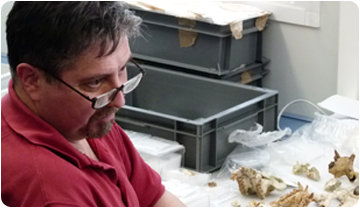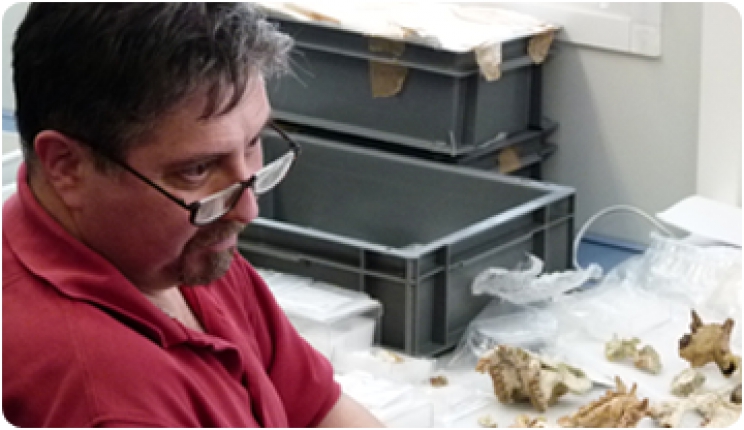
Professor David Begun at the ICP David Begun, Professor at the Department of Anthropology of the University of Toronto, visited last week the Institut Català de Paleontologia Miquel Crusafont (ICP). Begun works with the hypothesis that modern great apes (orangutans, gorillas and chimpanzees) including humans, evolved from a common European ancestor that migrated to Africa between 7 and 9 million years ago. Question: These days we have seen you at the lab looking at some of the iconic Miocene great apes fossils from the collection of ICP. ¿What’s the aim of your visit?
David Begun: My current field of research is the evolution of great apes in Europe. I work primarily in Hungary, where we have large collection of specimens from the Miocene and I wanted to compare the Hungarian samples that we have with the extensive collections from Catalonia. Thus, I've been looking at Hispanopithecus laietanus, Pierolapithecus catalaunicus, Dryopithecus fontani and Anoiapithecus brevirostris (all from Catalonia), to compare them with Rudapithecus hungaricus, which is the species found in Hungary. [Rudapithecus hungaricus is a 10 million year old hominoid. This species was described in 1967 from remains found in northern Hungary, in an town called Rudábanya.] Q.: What are the main differences between the species found in Catalonia and Rudapithecus? D.B.: The Hungarian species is very close to Hispanopithecus. Both Hispanopithecus and Rudapithecus are more modern-looking, they look more like modern great apes. Instead, Pierolapithecus, Anoiapithecus and Dryopithecus are a little bit older and more primitive-looking.
Q. In your opinion, what’s the importance of the samples found in the Valles-Penedes basin? The samples here, in the Vallès-Penedès basin is remarkable. You have so many specimens, including a good number of skeletons, which is very rare. It gives us a tremendous amount of information, not only about the anatomy and evolution of this animals, but how they behave, how they moved around in the environment, what kind of foods they ate… So, it’s an enormously rich resource for anyone interested in ape evolution. P.: Homoplasy is a quite common feature in this group. To what extend this phenomenon hinders its study? DB: (Laughs) Homoplasy occurs in all lineages throughout evolution. It’s a very fascinating phenomenon, but it makes it difficult to know if two characteristics are shared because they come from a common ancestor or were independently acquired. It makes it very challenging but I don’t think it's insurmountable. Q.: Where do you think we should look for the common ancestor of great apes and humans? DB: I believe that this ancestor lived and evolved in Europe. That’s what I call hominids and we don’t have any good evidence of hominids in Africa. The first time we come across hominids, we found them in Eurasia, in Europe, in particular. There are a couple of specimens from Africa that might be hominids, but right now the best evidence is that happened in Europe. Q.: One of your fields of research is the evolution of brain and the intelligence in this group. What can we say about its intelligence? DB:. In the samples from Hungary we do have a more complete braincases than those that have been so far found here, so we can get a good estimate of the brain size. We don’t know too much about the anatomy of the brain, its shape, but the brain size in Rudapithecus shows that it had a brain as large (relative to its body size) as a chimpanzee. And this is the oldest evidence we have for a chimpanzee’s size brain. Chimpanzees have large brains compared with monkeys and all other primates (but of course, they have much smaller than humans) so this is the beginning of the degree of brain development that we see in great apes. Because Rudapithecus is so similar to Hispanopithecus, I expect that Hispanopithecus had the same size brain, but we don’t have any direct evidence. If so, they probably had similar levels of intelligence to that which we see in chimpanzees today. |










